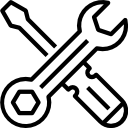4 QUESTIONS TO ASK
The proper installation of a stove can be complex and should be entrusted to a professional.
Over the years, the widespread availability of stoves in the market and large retail outlets has mistakenly led to the idea that a stove can be installed as a DIY project, which is highly discouraged and counterproductive.
A pellet stove is a device that generates flames, and improper installation can be dangerous. However, this is not the only reason why self-installation of a pellet stove is strongly discouraged: without certification from a qualified technician, you lose both the right to a warranty in case of malfunction and the right to tax benefits (50% deduction or Thermal Account).
Proper installation of a stove is essential to qualify for tax benefits, which require a declaration of conformity for the system. In other words, a certificate in which the technician certifies that all the legal requirements and standards related to the installation have been met.
Given that a professional is required for the installation of a pellet stove, here is what you should ask the technician to ensure you have the perfect system for your home.
1. WHICH STOVE MODEL TO CHOOSE AND WHERE TO INSTALL IT?
The work of a technician goes far beyond the installation itself. It starts long before, with the design of the system. A professional's job also involves studying, based on the client's objectives, the ideal location to install the stove, the required power, and the type of stove (including any ducting needed, requirements for heating water, technologies, etc.).
2. WHERE TO EXHAUST THE FUMES?
The exhaust of fumes is indispensable for the stove to function effectively and efficiently. Studying how and where to do this is the technician's responsibility, who, based on their direct experience with the product, is capable of evaluating the best solution. The technician is also knowledgeable about national, regional, and local regulations depending on the area where they operate.
Proper exhaust is important because, if done incorrectly, you could end up with a stove that doesn't heat enough or that generates smoke backflow into the room. Additionally, some types of installations (for example, stoves without a chimney) are non-compliant and can result in fines during inspections.
3. IS THE FIRST LIGHTING PLANNED?
Once the stove is installed, it is essential that the technician proceeds with the first ignition of the stove.
It may seem trivial, but it is very important that the first ignition is performed by experienced personnel: this operation is necessary to verify that the stove is installed correctly and that everything is functioning optimally.
It is the moment to have all the functions and technologies of the stove explained, and to complete the installation by adjusting the stove's parameters so that it fits perfectly with the requirements for which it was installed.
4. HOW TO CLEAN THE STOVE AND WHEN TO SCHEDULE MAINTENANCE?
From the technician, it's also important to learn how to clean and maintain the stove to keep it running efficiently over time.
Make sure to have them explain how to perform regular cleaning tasks that you'll need to do yourself, typically involving ash removal from the firebox and residue collection drawer.
Also ask if they will handle mandatory maintenance, which includes a more thorough cleaning of the stove and chimney, typically done once a year by a qualified technician. Many installers offer multi-year contracts for periodic maintenance, which is often more cost-effective than calling a technician last-minute.
Proper maintenance and cleaning will help ensure the longevity and proper functioning of your stove, resulting in long-term efficiency and savings.
As you've understood, the first step to having a beautiful and efficient stove is to entrust it to experienced hands.


